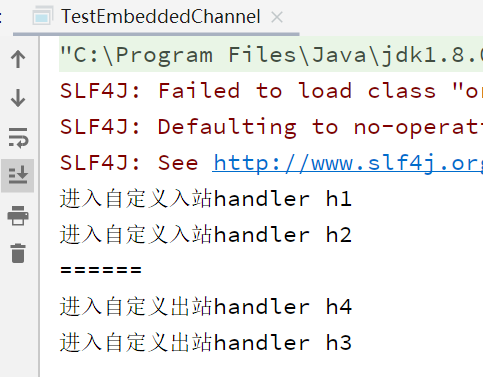EmbeddedChannel 可以查看具体的 handler 执行顺序
package channelhandler;import io.netty.buffer.ByteBufAllocator;import io.netty.channel.ChannelHandlerContext;import io.netty.channel.ChannelInboundHandlerAdapter;import io.netty.channel.ChannelOutboundHandlerAdapter;import io.netty.channel.ChannelPromise;import io.netty.channel.embedded.EmbeddedChannel;import java.nio.charset.StandardCharsets;/* Netty测试使用Channel,用于判断实际执行的handler顺序 */public class TestEmbeddedChannel {public static void main(String[] args) {ChannelInboundHandlerAdapter h1 = new ChannelInboundHandlerAdapter(){@Overridepublic void channelRead(ChannelHandlerContext ctx, Object msg) throws Exception {System.out.println("进入自定义入站handler h1");super.channelRead(ctx, msg);}};ChannelInboundHandlerAdapter h2 = new ChannelInboundHandlerAdapter(){@Overridepublic void channelRead(ChannelHandlerContext ctx, Object msg) throws Exception {System.out.println("进入自定义入站handler h2");super.channelRead(ctx, msg);}};ChannelOutboundHandlerAdapter h3 = new ChannelOutboundHandlerAdapter() {@Overridepublic void write(ChannelHandlerContext ctx, Object msg, ChannelPromise promise) throws Exception {System.out.println("进入自定义出站handler h3");super.write(ctx, msg, promise);}};ChannelOutboundHandlerAdapter h4 = new ChannelOutboundHandlerAdapter() {@Overridepublic void write(ChannelHandlerContext ctx, Object msg, ChannelPromise promise) throws Exception {System.out.println("进入自定义出站handler h4");super.write(ctx, msg, promise);}};EmbeddedChannel channel = new EmbeddedChannel(h1,h2,h3,h4);//模拟入站操作channel.writeInbound(ByteBufAllocator.DEFAULT.buffer().writeBytes("hello".getBytes(StandardCharsets.UTF_8)));System.out.println("======");//模拟出站操作channel.writeOutbound(ByteBufAllocator.DEFAULT.buffer().writeBytes("hello".getBytes(StandardCharsets.UTF_8)));}}


